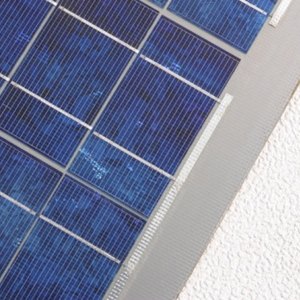
The United States government makes mitigating the effects of climate change, and continuing a trend toward energy independence, a top priority. Toward these ends, many federal agencies are charged with spurring the development and usage of renewable energy sources.
Among the most approved forms is solar energy. Solar panels, composed of photovoltaic cells, turn the rays of the sun into electricity by allowing photons to sever electrons from atoms thereby generating electric power. Panels are used at industrial sites, office parks, college campuses and, increasingly, at private residences. The government offers financial assistance to such homeowners in various forms.
Are Solar Panels Expensive?
Considering that those who opt to purchase solar panels are taking on a miniature power plant, solar panels constitute a significant investment. The U.S. Department of Energy's (DOE) National Renewable Energy Laboratory calculates that the typical system runs about $2.71 per watt generated. Given that panels for private homes produce five kilowatts on average, that puts the estimate at over $13,000. It should be noted that there are variables like manufacturer, size and grid/off-grid that affect pricing.
Loan Assistance for Solar Panels
Solar panels can save residents considerable dollars toward their electric bills, often paying for themselves eventually. What about the upfront costs of purchase and installation? Are there solar panel grants for homeowners? In truth, grants are tough to find, but financing is readily available.
The Federal Housing Administration offers home improvement and rehabilitation mortgages (203k) through local banks and lenders. Installing a solar power system is easily included among the eligible renovations.
Similar help is provided through Fannie Mae's Homestyle Renovation Loan, allowing a 97 percent loan-to-value ratio. Many mortgage analysts observe that these loans are more easily underwritten at the time of home purchase than as refinances.
Tax Incentives for Solar Panels
Government grants for solar panels can take other forms. One major example is the ENERGY STAR program, jointly administered by DOE and the U.S. Environmental Protection Agency (EPA). This initiative is directed at improving the power efficiency of buildings and appliances.
The incorporation of household staples, like washers, dryers, refrigerators and ceiling fans, that conform to ENERGY STAR's efficiency standards can make a home eligible for credits against the household's annual income tax obligation. Solar panels are among the improvements that earn this reward through the Federal Solar Tax Credit. Many state governments offer similar incentives.
State Help for Solar Panel Investment
Individual states also do their part to encourage energy conservation and lower environmental impact. For example, New Jersey conducts a net metering program whereby utility customers can sell excess electricity from solar production back to the electrical grids. The Garden State also offers exemptions on home sale taxes and property tax assessments that go up because of the solar panels.
Minnesota runs similar programs and adds its SolarSense rebate on a lottery basis. This means that some solar customers are reimbursed up to 60 percent of the cost of panels and installation.
Savings with Solar Panels
Perhaps the biggest incentive to purchase and furnish a home with solar panels is the long-term savings accrued, especially when living in climates that have lengthy hot or cold seasons. Other factors are the dimensions of a home's roof, the average annual energy usage and the rates charged by the local utility.
Averaging these variables over the entire United States, analysts estimate that the annual savings could amount to about $1,400 per year. Such economies can increase household cash flow and add to the family's financial assets.
References
Resources
Writer Bio
Adam Luehrs is a writer during the day and a voracious reader at night. He focuses mostly on finance writing and has a passion for real estate, credit card deals, and investing.

